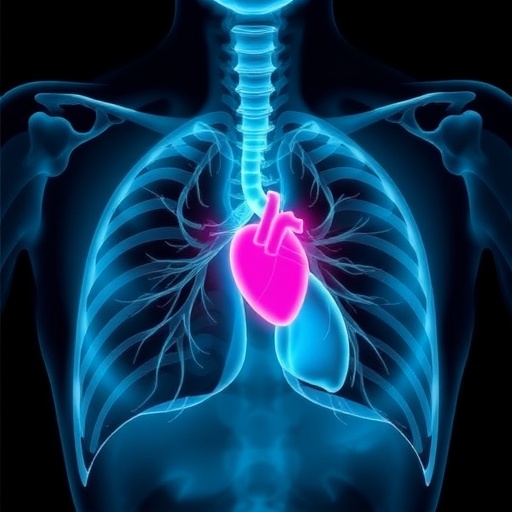In a groundbreaking study published in BMC Pediatrics, the intricate realms of prenatal diagnostics and postnatal management for neonatal complications have been explored in the context of pulmonary valve stenosis—an abnormal narrowing of the pulmonary valve that can lead to significant cardiovascular distress if not managed appropriately. The case report discussed presents a comprehensive narrative that not only elucidates the procedure and challenges of diagnosis before birth but also meticulous strategies for managing the condition after the infant’s arrival.
Pulmonary valve stenosis affects the heart’s ability to efficiently pump blood into the lungs, often placing considerable strain on the right ventricle. This condition requires prompt attention both during pregnancy and after the child is born. The authors of the study, Golbabaei and Mohammad Talebi, delve into the methods used for prenatal diagnosis, revealing a multifaceted approach that relies on advanced imaging techniques, such as echocardiography. Their meticulous methodology aims to identify the severity of the stenosis while considering potential comorbidities that could complicate treatment.
The anticipation surrounding advancements in prenatal imaging has transformed the landscape of fetal medicine. Through the use of high-resolution ultrasound technology and Doppler studies, practitioners can now obtain detailed insights into fetal heart structure and function. This is crucial because early identification of conditions like pulmonary valve stenosis can significantly influence the management plan, allowing for timely intervention and better outcomes.
In the reported case, the fetus was diagnosed with severe pulmonary valve stenosis during the second trimester. This discovery initiated a collaborative care approach involving cardiologists and obstetricians, marking a pivotal moment in the prenatal management process. The experts involved aimed not only to monitor the fetus’s heart condition but also to counsel the parents about potential outcomes, risks, and treatment options that could be necessary post-birth.
As the pregnancy progressed, care was taken to conduct regular follow-ups. These included additional echocardiograms to scrutinize the heart’s functionality and the degree of stenosis, ensuring that the mother and fetus remained healthy while preparing for any interventions that might be necessary at delivery. This hands-on approach is becoming a standard in managing similar congenital heart defects, allowing medical professionals to tailor their strategies as needed based on the evolving clinical picture.
Once the infant was born, immediate assessments were vital to ascertain the extent of the pulmonary valve stenosis. This phase of care is critical, for it tests the groundwork laid during the prenatal stage. If untreated, severe cases of pulmonary valve stenosis can lead to a series of complications, including right ventricular hypertrophy and potential heart failure. Therefore, a swift yet comprehensive evaluation, often involving echocardiograms and possibly cardiac catheterization, is essential in formulating a treatment plan.
Interventions for managing postnatal pulmonary valve stenosis may range from balloon valvuloplasty to surgical repair, depending on the severity of the condition and the infant’s overall health. The authors recount the decision-making process regarding the infant’s care, which necessitated thorough discussions between parents and medical teams. They highlight that understanding the available options and their implications is crucial for informed consent and effective management.
Throughout the following weeks, the infant was closely monitored to assess the response to treatment and identify any potential complications. This ongoing evaluation is vital, as children with congenital heart defects may face various challenges as they grow. Regular follow-ups are imperative to ensure that the heart is developing properly, as well as to check for any issues that might arise from the initial condition or its treatment.
The case presented by Golbabaei and Talebi exemplifies the beautiful synergy between prenatal care and postnatal management. It brings to light the importance of early detection, informed decision-making, and adaptive treatment strategies in managing complex congenital heart conditions. Their work underscores the role of interdisciplinary collaboration, as these complex cases often require the expertise of various specialists, including pediatric cardiologists, obstetricians, and neonatologists.
As the world of pediatric cardiology continues to evolve, with ongoing research and advancements in technology, the outcomes for children born with conditions such as pulmonary valve stenosis are steadily improving. The narrative shared in this case report reflects hope and progress, showcasing how modern medicine’s collective efforts can lead to better prognoses for affected infants.
The journey does not end with the successful management of pulmonary valve stenosis; rather, it marks a new chapter in the child’s life that requires vigilant monitoring and continual care. The recommendations for ongoing assessments highlight this necessity, illustrating the importance of a lasting relationship between families and healthcare providers in the management of congenital heart defects.
In conclusion, the exploration of prenatal diagnosis and postnatal management highlights the critical nature of early detection and comprehensive care pathways. The insights derived from the case report not only add to the existing literature but also serve as a beacon for future endeavors in the field of pediatric cardiology. The collaboration between experts and families, alongside the advancements in medical technology, is paving the way for successful outcomes in the management of congenital heart defects like pulmonary valve stenosis.
This journey encompasses not only the medical science behind the diagnosis and management of pulmonary valve stenosis but also reflects the emotional landscape of families navigating these challenges, emphasizing the profound impact of healthcare advancements on their lives.
Subject of Research: Prenatal diagnosis and postnatal management of pulmonary valve stenosis
Article Title: Prenatal diagnosis and postnatal management of a complicated pulmonary valve stenosis: a case report.
Article References:
Golbabaei, A., Mohammad Talebi, H. Prenatal diagnosis and postnatal management of a complicated pulmonary valve stenosis: a case report.
BMC Pediatr 25, 692 (2025). https://doi.org/10.1186/s12887-025-06078-6
Image Credits: AI Generated
DOI:
Keywords: pulmonary valve stenosis, prenatal diagnosis, postnatal management, congenital heart defects, echocardiography, balloon valvuloplasty, pediatric cardiology.
Tags: advancements in fetal imaging techniquescase study in pediatric cardiologychallenges in diagnosing heart abnormalitiescomorbidities in congenital heart defectsDoppler studies in prenatal careechocardiography in fetal medicinehigh-resolution ultrasound technologyneonatal cardiovascular complicationspostnatal management strategiesprenatal diagnostics for heart conditionspulmonary valve stenosis managementright ventricle strain in infants





